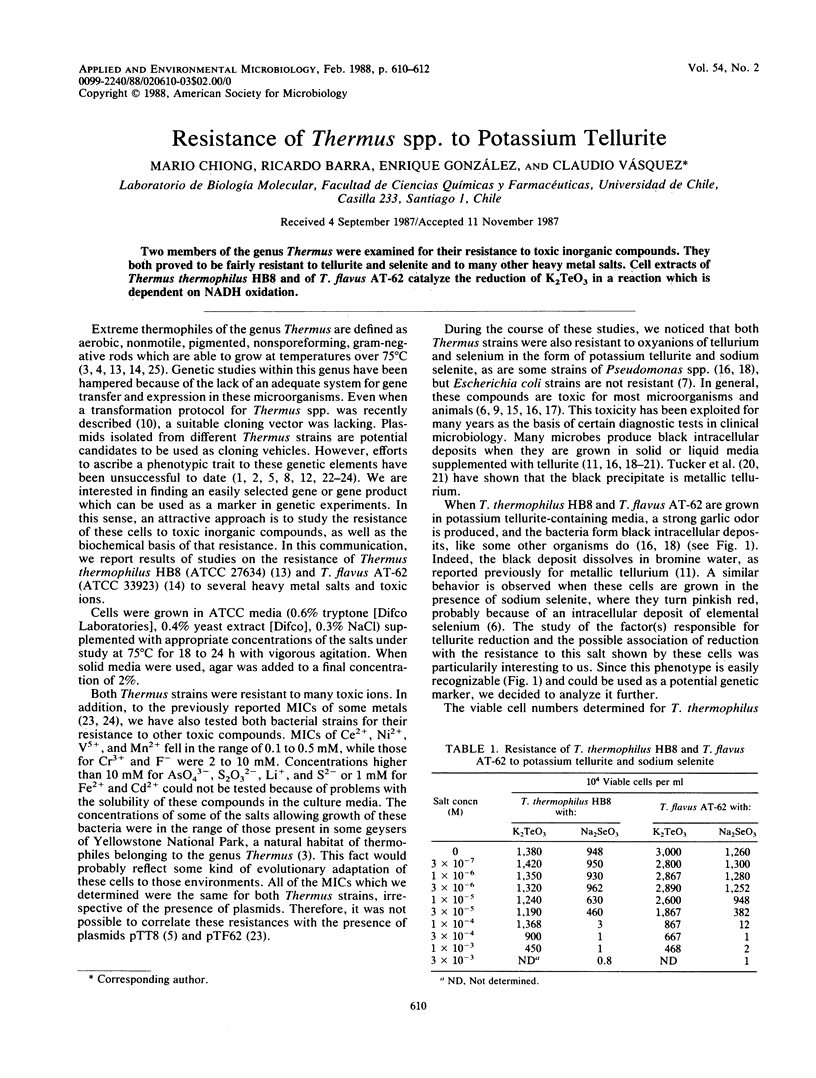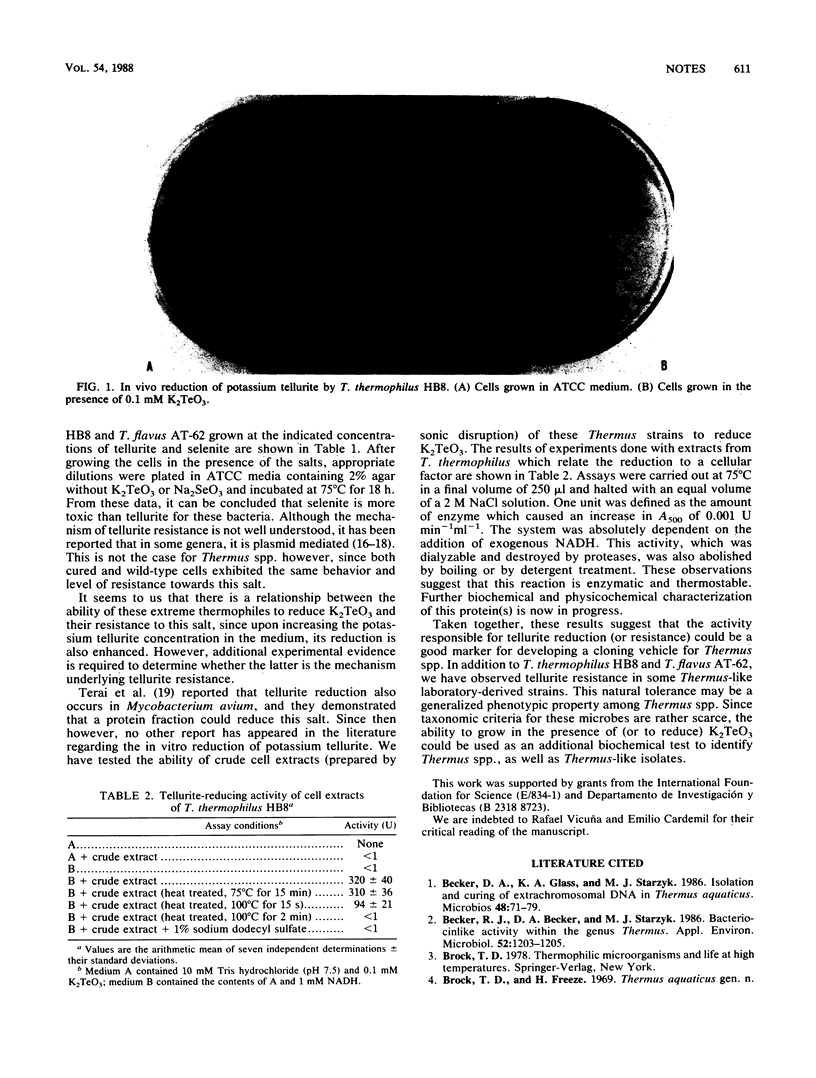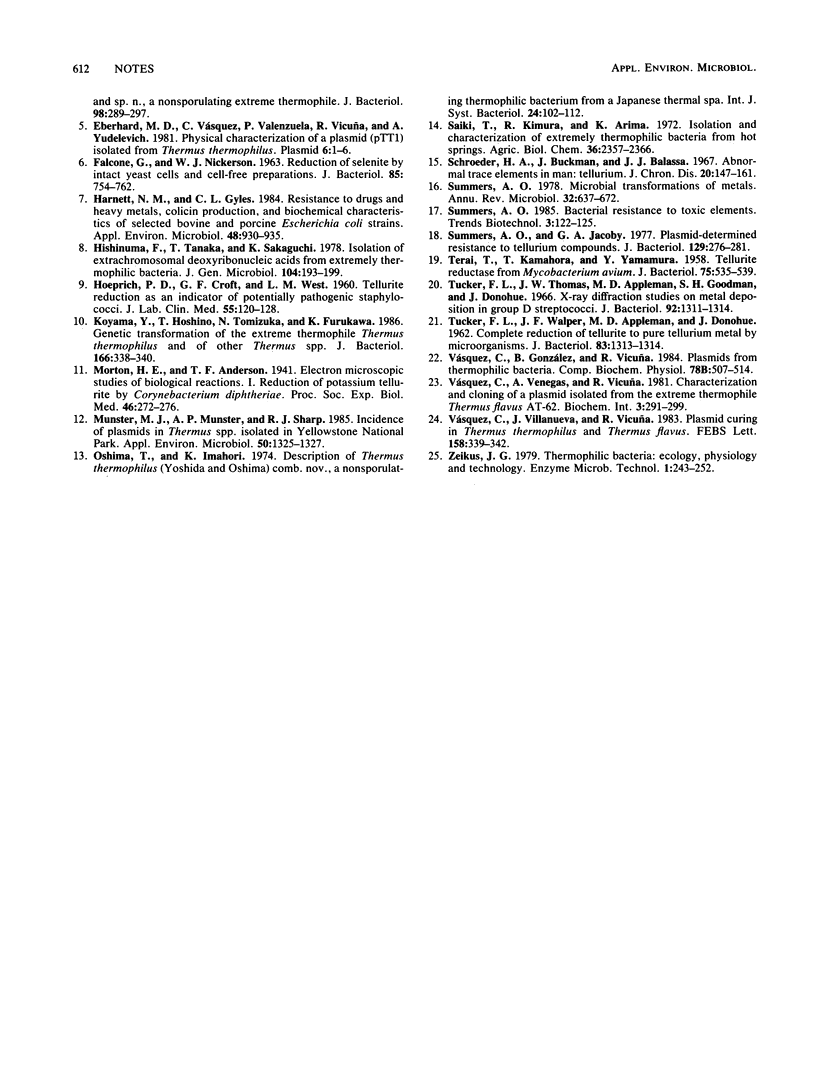Abstract
Two members of the genus Thermus were examined for their resistance to toxic inorganic compounds. They both proved to be fairly resistant to tellurite and selenite and to many other heavy metal salts. Cell extracts of Thermus thermophilus HB8 and of T. flavus AT-62 catalyze the reduction of K2TeO3 in a reaction which is dependent on NADH oxidation.
Full text
PDF


Images in this article
Selected References
These references are in PubMed. This may not be the complete list of references from this article.
- Becker R. J., Becker D. A., Starzyk M. J. Bacteriocinlike Activity within the Genus Thermus. Appl Environ Microbiol. 1986 Nov;52(5):1203–1205. doi: 10.1128/aem.52.5.1203-1205.1986. [DOI] [PMC free article] [PubMed] [Google Scholar]
- Eberhard M. D., Vásquez C., Valenzuela P., Vicuña R., Yudelevich A. Physical characterization of a plasmid (pTT1) isolated from Thermus thermophilus. Plasmid. 1981 Jul;6(1):1–6. doi: 10.1016/0147-619x(81)90049-4. [DOI] [PubMed] [Google Scholar]
- FALCONE G., NICKERSON W. J. REDUCTION OF SELENITE BY INTACT YEAST CELLS AND CELL-FREE PREPARATIONS. J Bacteriol. 1963 Apr;85:754–762. doi: 10.1128/jb.85.4.754-762.1963. [DOI] [PMC free article] [PubMed] [Google Scholar]
- HOEPRICH P. D., CROFT G. F., WEST L. M., 2nd Tellurite reduction as an indicator of potentially pathogenic stapylococci. J Lab Clin Med. 1960 Jan;55:120–128. [PubMed] [Google Scholar]
- Harnett N. M., Gyles C. L. Resistance to drugs and heavy metals, colicin production, and biochemical characteristics of selected bovine and porcine Escherichia coli strains. Appl Environ Microbiol. 1984 Nov;48(5):930–935. doi: 10.1128/aem.48.5.930-935.1984. [DOI] [PMC free article] [PubMed] [Google Scholar]
- Hishinuma F., Tanaka T., Sakaguchi K. Isolation of extrachromosomal deoxyribonucleic acids from extremely thermophilic bacteria. J Gen Microbiol. 1978 Feb;104(2):193–199. doi: 10.1099/00221287-104-2-193. [DOI] [PubMed] [Google Scholar]
- Koyama Y., Hoshino T., Tomizuka N., Furukawa K. Genetic transformation of the extreme thermophile Thermus thermophilus and of other Thermus spp. J Bacteriol. 1986 Apr;166(1):338–340. doi: 10.1128/jb.166.1.338-340.1986. [DOI] [PMC free article] [PubMed] [Google Scholar]
- Munster M. J., Munster A. P., Sharp R. J. Incidence of Plasmids in Thermus spp. Isolated in Yellowstone National Park. Appl Environ Microbiol. 1985 Nov;50(5):1325–1327. doi: 10.1128/aem.50.5.1325-1327.1985. [DOI] [PMC free article] [PubMed] [Google Scholar]
- Schroeder H. A., Buckman J., Balassa J. J. Abnormal trace elements in man: tellurium. J Chronic Dis. 1967 Mar;20(3):147–161. doi: 10.1016/0021-9681(67)90049-5. [DOI] [PubMed] [Google Scholar]
- Summers A. O., Jacoby G. A. Plasmid-determined resistance to tellurium compounds. J Bacteriol. 1977 Jan;129(1):276–281. doi: 10.1128/jb.129.1.276-281.1977. [DOI] [PMC free article] [PubMed] [Google Scholar]
- Summers A. O., Silver S. Microbial transformations of metals. Annu Rev Microbiol. 1978;32:637–672. doi: 10.1146/annurev.mi.32.100178.003225. [DOI] [PubMed] [Google Scholar]
- TERAI T., KAMAHORA T., YAMAMURA Y. Tellurite reductase from Mycobacterium avium. J Bacteriol. 1958 May;75(5):535–539. doi: 10.1128/jb.75.5.535-539.1958. [DOI] [PMC free article] [PubMed] [Google Scholar]
- TUCKER F. L., WALPER J. F., APPLEMAN M. D., DONOHUE J. Complete reduction of tellurite to pure tellurium metal by microorganisms. J Bacteriol. 1962 Jun;83:1313–1314. doi: 10.1128/jb.83.6.1313-1314.1962. [DOI] [PMC free article] [PubMed] [Google Scholar]
- Tucker F. L., Thomas J. W., Appleman M. D., Goodman S. H., Donohue J. X-ray diffraction studies on metal deposition in group D streptococci. J Bacteriol. 1966 Nov;92(5):1311–1314. doi: 10.1128/jb.92.5.1311-1314.1966. [DOI] [PMC free article] [PubMed] [Google Scholar]



